There are far too many sites that have great spiritual significance for Buddhists for any short list to contain them all. But we will look at a sampling of such destinations in five countries.
– INDIA AND NEPAL
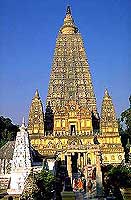 India is the birthplace of Siddhartha Gautama, the Prince who was to become the Buddha, though the modern borders of these nations actually place the Buddha’s birthplace in the small Himalayan nation of Nepal. Buddhism became one of the great religions of India and Asia. Eventually it faded to very much a minority religion in India itself as it flourished elsewhere, but there remain many sites of great historical importance to Buddhism in India and Nepal.
India is the birthplace of Siddhartha Gautama, the Prince who was to become the Buddha, though the modern borders of these nations actually place the Buddha’s birthplace in the small Himalayan nation of Nepal. Buddhism became one of the great religions of India and Asia. Eventually it faded to very much a minority religion in India itself as it flourished elsewhere, but there remain many sites of great historical importance to Buddhism in India and Nepal.
Buddhist teachings say that before his death, the Buddha stated that his followers were to make pilgrimages in their lifetime to four sites that had great significance to his life. These are Lumbini, his birthplace near the Nepal-India border; Uruvela, now called Bodh Gaya in the Indian state of Bihar, the place of his enlightenment; Sarnath, in the Indian state of Uttar Pradesh, the site of his first sermon; and Kushavati, now called Kushinagar and also in Uttar Pradesh, where he resided late in his life until he died.
All of these sites were destroyed over time as Buddhism declined in India, but they have recently been restored. All are worthy destinations to visit, but perhaps Bodh Gaya is most to be recommended.
Bodh Gaya serves today as a complex of Buddhist monasteries and meditation centers, as well as Hindu and Buddhist museums. A descendant of the bodhi tree under which the Buddha is said to have had his spiritual awakening is particularly appreciated by visitors. You will also be able to see the Buddha’s stone seat, as well as a restored Buddhist temple that dates all the way back to the 7th century.
– SRI LANKA
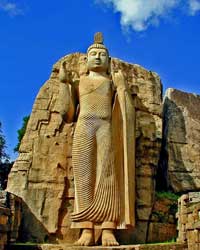 As Buddhism all but died out in India, one of the places where it has thrived for over 2,000 years is the island of Ceylon, which is now the modern country of Sri Lanka. Sri Lanka today is approximately 70% Buddhist.
As Buddhism all but died out in India, one of the places where it has thrived for over 2,000 years is the island of Ceylon, which is now the modern country of Sri Lanka. Sri Lanka today is approximately 70% Buddhist.
One of the most awe-inspiring of destinations for the tourist interested in Buddhism is Anuradhapura, the one time capital of Sri Lanka, in the northern portion of the country. Anuradhapura dates back to 250 BCE, shortly after the introduction of Buddhism to Sri Lanka. For over a millennium the site had been in a state of disuse, overrun by jungle, until recently it was partially restored.
Only partially though. Anuradhapura very much retains the feel of ruins thousands of years old. The site includes two imposing giant domed stupas (sacred Buddhist burial mounds containing the bodies of saints and other relics), the Thuparama monument which is believed to be the oldest surviving Buddhist monument in India or Sri Lanka, ruins of monasteries including the Great Monastery of Mahavihara, reservoirs and sculptures, and a descendent of the original bodhi tree, brought to Sri Lanka from India.
Anuradhapura comes alive in May and June, when great festivals drawing hundreds of thousands of Buddhists are held on the full moon days.
Anuradhapura is just eight miles from another site of significance to Sri Lankan Buddhism, Mihintale, where the monk Mahindra who is credited with introducing Buddhism to Sri Lanka first preached. Visitors can conveniently visit both sites.
– CHINA
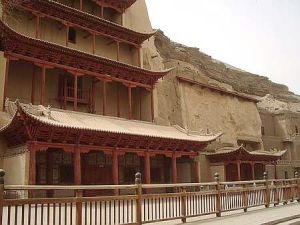 Historians believe Buddhism was probably introduced into China in the 3rd century BCE, though other dates have been suggested. In time it flourished as one of the major faiths of the Chinese people. It was in and out of favor to varying degrees under different rulers, took on a distinctively Chinese flavor as it merged in certain respects with Taoism and Confucianism, then declined significantly starting in the 9th century. In the 20th century, what was left of Buddhism in China was actively suppressed, along with other religions, by the Communist regime.
Historians believe Buddhism was probably introduced into China in the 3rd century BCE, though other dates have been suggested. In time it flourished as one of the major faiths of the Chinese people. It was in and out of favor to varying degrees under different rulers, took on a distinctively Chinese flavor as it merged in certain respects with Taoism and Confucianism, then declined significantly starting in the 9th century. In the 20th century, what was left of Buddhism in China was actively suppressed, along with other religions, by the Communist regime.
During a time in the 5th century when there was concern over recent persecution of Buddhists, the emperor of the first Wei dynasty ordered work started on great cave shrines in Yun-Kang in the province of Shanxi, and Lung-Men in the province of Honan. Over a period of decades, gigantic Buddhas and extensive narrative reliefs were carved meticulously out of the rock.
The massive Buddhas of Yun-Kang are carved in a manner closer to the way the Buddha was traditionally depicted in India. Those of Lung-Men have a more recognizably Chinese sculpture style, and are considered by some the greatest artistic achievement of the Wei dynasty.
Tibet, which is now a part of China, though a disputed one, is the one exception where Buddhism in China is a key part of the present and not just the past. The holy city of Lhasa in Tibet contains the palace of the Dalai Lama, now a state museum. Most of the 17th century palace and its contents have been excellently preserved.
– JAPAN
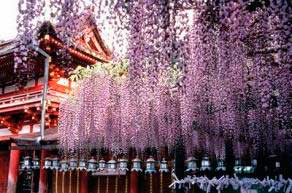 Though there may have been some limited awareness of it earlier in Japan, Buddhism took root in the island nation in the 6th century, and grew to become the majority religion. Today 70% of Japan remains at least nominally Buddhist, though the country has become more secularized in recent decades.
Though there may have been some limited awareness of it earlier in Japan, Buddhism took root in the island nation in the 6th century, and grew to become the majority religion. Today 70% of Japan remains at least nominally Buddhist, though the country has become more secularized in recent decades.
As important as any site to visit for one interested in Japanese Buddhism is Nara, the Japanese capital in the 8th century. Nara-koen Park, near the center of the city, contains much of historical significance. In addition to the Todai-ji temple with its giant, imposing bronze Buddha, there are other Buddhist temples and shrines, pagodas, Shinto shrines, beautiful gardens, a national museum, and hundreds of freely roaming deer.
– CAMBODIA
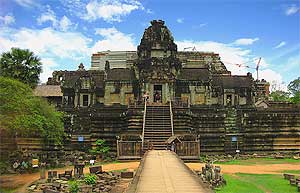 Buddhism was introduced into Southeast Asia by Indian traders early in its history. In much of that part of the world, it came to be the dominant religion, though it was a version that combined elements of Hinduism, Buddhism, and remnants of the belief systems that had already existed in those countries. In Cambodia today, for instance, 95% of the population considers itself Buddhist.
Buddhism was introduced into Southeast Asia by Indian traders early in its history. In much of that part of the world, it came to be the dominant religion, though it was a version that combined elements of Hinduism, Buddhism, and remnants of the belief systems that had already existed in those countries. In Cambodia today, for instance, 95% of the population considers itself Buddhist.
The region of Angkor in Cambodia is home to the great temple complexes of Angkor Wat and Angkor Thom, the former built by a Hindu Khmer ruler, and the latter by a Buddhist Khmer ruler. Both combine Hindu and Buddhist iconography, and are among the most impressive sites in all of Southeast Asia. Angkor Wat, in fact, appears on the Cambodian flag.
Angkor Thom was structured as a model of the Buddhist universe. The temple towers contain giant carvings of the King Jayavarman who presided over the building of Angkor Thom in the 12th century, depicted as part man/part deity. The complex is surrounded by a great moat, and contains within it an elaborate system of irrigation canals, an impressive engineering feat for its time.
Source: The Buddhist Channel




